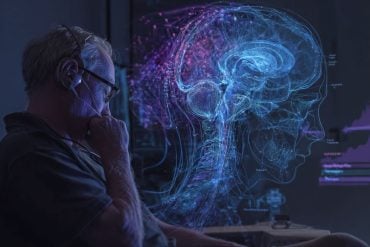Summary: A new study uncovers the mechanism behind cognitive dissonance.
Source: HSE.
A new study by HSE researchers has uncovered a new brain mechanism that generates cognitive dissonance – a mental discomfort experienced by a person who simultaneously holds two or more contradictory beliefs or values, or experiences difficulties in making decisions. The results of the study have been published in the paper ‘Open Access Neural Mechanisms of Cognitive Dissonance (Revised): an EEG Study’ in The Journal of Neuroscience.
In psychology, cognitive dissonance is viewed as mental stress (discomfort) experienced by a person who simultaneously holds two or more contradictory beliefs, ideas, or values (i.e., when performing an action that contradicts one of those beliefs, ideas, or values; or when confronted with new information that contradicts one of those beliefs, ideas, and values). Such discomfort (cognitive dissonance) pushes people to change their behaviour and/or adjust their values and preferences in order to restore a ‘mental balance’. Researchers from the HSE Centre for Cognition & Decision Making carried out an experiment aimed at investigating what happens in the human brain when a person experiences cognitive dissonance.
‘Imagine you are choosing between two similar car brands. You’ve made a choice, but then you experience a cognitive dissonance, since you’ve given up on one of the attractive brands,’ said Vasily Klucharev, Head of the Centre for Cognition & Decision Making, explaining the basis of the experiment, adding: ‘This research demonstrates that, in such situations, you start valuing the denied car less. To keep a mental balance, we start thinking that the car we didn’t choose wasn’t that good at all’.
In this experiment, the researchers created a situation featuring a strong cognitive dissonance, and a lack of it. The examinees were asked to evaluate approximately 400 food products. On the basis of their responses, pairs of products were chosen, of which the participants could only choose one, in order to obtain it at the end of the experiment. When they liked one product and disliked the other, the respondents didn’t have any problem. However, they faced difficulties when the products were similarly attractive. It was during such situations they experienced a cognitive dissonance.

The authors of the study were the first to demonstrate that individual differences in resting-state brain activity can predict the impact of cognitive dissonance when a person faces a series of difficult decisions. Long before decisions had to be made, a ‘critical state’ of the frontal cortex was measured (i.e., an index of neuronal self-organization). Recent studies have demonstrated that a large variety of complex processes, including forest fires, earthquakes, financial markets, heartbeats, and human coordination exhibit self-organization (or ‘critical states’). The researchers therefore uncovered a link between the individual index of self-organization in the frontal cortices during rest and the subsequent neural and behavioural effects of cognitive dissonance. Individuals with stronger self-organization in the frontal cortex demonstrated a greater influence of cognitive dissonance on their behaviour.
This study also indicated that decisions associated with higher levels of cognitive dissonance elicited a fast frontal electrophysiological signal that peaked ~60 ms after the difficult decision. This transient activity appeared to be in correlation with the behavioural effects of cognitive dissonance and resting-state brain activity.
Furthermore, the study’s results suggest that cognitive dissonance is reflected in both resting-state and decision-related activity of the prefrontal cortex, which monitors internal conflicts and mistakes.
Source: Liudmila Mezentseva – HSE
Image Source: NeuroscienceNews.com image is in the public domain.
Original Research: Full open access research for “Neural mechanisms of cognitive dissonance (revised): An EEG study” by Marco Colosio, Anna Shestakova, Vadim V. Nikulin, Evgeny Blagovechtchenski and Vasily Klucharev in Journal of Neuroscience. Published online April 24 2017 doi:10.1523/JNEUROSCI.3209-16.2017
[cbtabs][cbtab title=”MLA”]HSE “Researchers Predict Cognitive Dissonance By Looking At Brain Activity.” NeuroscienceNews. NeuroscienceNews, 17 May 2017.
<https://neurosciencenews.com/cognitive-dissonance-brain-activity-6709/>.[/cbtab][cbtab title=”APA”]HSE (2017, May 17). Researchers Predict Cognitive Dissonance By Looking At Brain Activity. NeuroscienceNew. Retrieved May 17, 2017 from https://neurosciencenews.com/cognitive-dissonance-brain-activity-6709/[/cbtab][cbtab title=”Chicago”]HSE “Researchers Predict Cognitive Dissonance By Looking At Brain Activity.” https://neurosciencenews.com/cognitive-dissonance-brain-activity-6709/ (accessed May 17, 2017).[/cbtab][/cbtabs]
Abstract
Neural mechanisms of cognitive dissonance (revised): An EEG study
Cognitive dissonance theory suggests that our preferences are modulated by the mere act of choosing. A choice between two similarly valued alternatives creates psychological tension (cognitive dissonance) that is reduced by a post-decisional reevaluation of the alternatives. We measured EEG of human subjects during rest and free-choice paradigm. Our study demonstrates that choices associated with stronger cognitive dissonance trigger a larger negative fronto-central evoked response similar to error-related negativity (ERN), which has in turn been implicated in general performance monitoring. Furthermore, the amplitude of the evoked response is correlated with the reevaluation of the alternatives. We also found a link between individual neural dynamics (long-range temporal correlations— LRTC) of the fronto-central cortices during rest and follow-up neural and behavioral effects of cognitive dissonance. Individuals with stronger resting-state LRTC demonstrated a greater post-decisional reevaluation of the alternatives and larger evoked brain responses associated with stronger cognitive dissonance. Thus, our results suggest that cognitive dissonance is reflected in both resting-state and choice-related activity of the prefrontal cortex as part of the general performance-monitoring circuitry.
SIGNIFICANCE STATEMENT
Contrary to traditional decision theory, behavioral studies repeatedly demonstrate that our preferences are modulated by the mere act of choosing. Difficult choices generate psychological (cognitive) dissonance, which is reduced by the post-decisional devaluation of unchosen options. We found that decisions associated with a higher level of cognitive dissonance elicited a stronger negative fronto-central deflection that peaked ∼60 ms after the response. This activity shares similar spatial and temporal features as error-related negativity (ERN)—the electrophysiological correlate of performance monitoring. Furthermore, the fronto-central resting-state activity predicted the individual magnitude of preference change and the strength of cognitive dissonance-related neural activity.
“Neural mechanisms of cognitive dissonance (revised): An EEG study” by Marco Colosio, Anna Shestakova, Vadim V. Nikulin, Evgeny Blagovechtchenski and Vasily Klucharev in Journal of Neuroscience. Published online April 24 2017 doi:10.1523/JNEUROSCI.3209-16.2017






